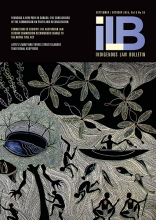Indigenous Law Bulletin 8(20)

EDITORIAL
On 2 June 2015, the conclusions of the Commission on Truth and Reconciliation in Canada were presented by Justice Murray Sinclair. As Dr Sandy Lamalle writes, the Commission’s conclusions are comprehensive and address historical, political, ideological, cultural, economic, legal and spiritual concerns. They include the documentation of 10 ‘Principles of Reconciliation’, the creation of a National Centre for Truth and Reconciliation, and the issue of 94 policy recommendations. The conclusions of the Commission were well received across Canadian society, and were endorsed by the then Prime Minister Stephen Harper. The Commission’s report also prompted discussions about reconciliation to take place as part of the federal election campaigns, which included newly elected Prime Minister Justin Trudeau promising to open
an inquiry on missing and murdered Aboriginal women and to build a ‘renewed relationship’ with every First Nation in Canada. While a positive outcome for Canada, the process and findings of the Commission also highlight how significantly Australia is trailing behind in terms of ventilating and taking action to address issues around reconciliation and recognition.
Also in this edition, we revisit the closure of the Oombulgurri community in 2011, in light of the Western Australian government’s announcement of its intention to cease the funding of essential services to up to 150 remote communities. Tammy Solonec and Cassandra Seery of Amnesty International question whether the actions of the Western Australian government in relation to the closure of Oombulgurri were lawful, and whether they contravened Australia’s obligations as a state party to international human rights covenants; and Dennis Eggington and Sarouche Razi draw a line between the community’s closure and the historical casting of Aboriginal people as ‘Other’ in a compelling piece that makes for extremely concerning reading. The closure of remote communities looks set to be an ongoing issue, and the actions of various governments need to be scrutinised; the ILB is committed to being a part of that scrutiny process.
Finally, this edition of the ILB is my first as editor, having taken over from Rebecca Gallegos whose work as editor since 2013 I would like to acknowledge and thank her for. I am honoured to edit such a highly regarded and important publication, and want to thank UNSW Law, the Indigenous Law Centre and the ILB’s many valued contributors for their warm welcome. I look forward to continuing the proud publishing tradition of the ILB, and to engaging with ILB readers through not only its pages, but also at future ILC events and in the community.
Emma Rafferty
Editor
CONTENTS
FOUNDING A NEW PATH IN CANADA: THE CONCLUSIONS OF THE COMMISSION ON TRUTH AND RECONCILIATION
by Sandy Lamalle
WHO OWNS COPYRIGHT IN NATIVE TITLE CONNECTION REPORTS?
by Eamon Ritchie and Terri Janke
CONNECTION TO COUNTRY: THE AUSTRALIAN LAW REFORM COMMISSION RECOMMENDS CHANGE TO THE NATIVE TITLE ACT
by Robyn Gilbert
THE OOMBULGURRI EVICTION: PRACTICALITY OR ILLEGALITY?
by Tammy Solonec and Cassandra Seery
EATTS V GUNDY AND TORRES STRAIT ISLANDER TRADITIONAL ADOPTIONS
by Heron Loban, Aiden Booker and Kathryn van Doore
THE BOGEYMAN IN THE MIRROR: WHITE AUSTRALIA AND THE PROPOSAL TO CLOSE REMOTE COMMUNITIES IN WESTERN AUSTRALIA
by Dennis Eggington and Sarouche Razi
Featured article:
